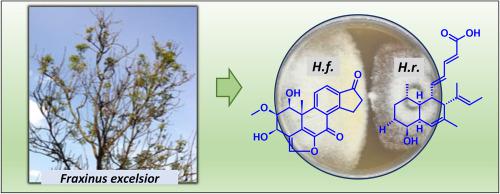Fungal Ecology ( IF 1.9 ) Pub Date : 2020-02-19 , DOI: 10.1016/j.funeco.2020.100918 Sandra Halecker , Jan-Peer Wennrich , Sara Rodrigo , Nicole Andrée , Laura Rabsch , Christiane Baschien , Michael Steinert , Marc Stadler , Frank Surup , Barbara Schulz

|
Our goal is to develop a biocontrol agent using endophytic fungi to control ash dieback, a disease that endangers the very existence of the European ash, Fraxinus excelsior. Such a protective endophyte should produce metabolites toxic to the invasive fungus Hymenoscyphus fraxineus, the causal agent of ash dieback. From a total of 340 fungal endophytes from F. excelsior, the interactions with 13 exemplary isolates are presented here. In co-culture between H. fraxineus and endophyte, there was almost always reciprocal inhibition between pathogen and endophyte. Endophytes that inhibited H. fraxineus more than they were inhibited by the pathogen were inoculated into axenically cultured F. excelsior to select those that grew asymptomatically in the host. Most of the endophytes caused disease symptoms in axenically cultured F. excelsior seedlings, highlighting the importance of not only relying on co-culture experiments, but also using in planta experiments. By means of a multi-locus genealogy in conjunction with morphological studies and a comparison with the ex-epitype culture, one of the most promising isolates was identified as Hypoxylon rubiginosum, an ascomycete fungus that is closely associated with Fraxinus and frequently produces its sexual morph on dead wood of the host. Using preparative HPLC, metabolites were isolated from mono- and co-cultures of H. fraxineus and H. rubiginosum and their structures elucidated by NMR spectroscopy and HR mass spectrometry. The known phytotoxin viridiol was detected as a major metabolite of the ash pathogen in co-culture and the previously known antifungal metabolite, phomopsidin, as the major secondary metabolite of H. rubiginosum. In addition, the new metabolite, 10-hydroxyphomopsidin, was obtained from H. rubiginosum. Phomopsidin, a known inhibitor of beta-tubulin that targets the eukaryotic cytoskeleton, inhibited the pathogen, but also showed mild cytotoxic effects. The fact that H. rubiginosum grows asymptomatically in planta and that it produces the antifungal metabolite phomopsidin qualifies it as a promising candidate for further development as a biocontrol agent for ash dieback.
中文翻译:

真菌内生菌对灰分生的生物防治:红花hyperoxylon rubiginosum的拮抗潜力
我们的目标是开发一种使用内生真菌控制灰烬枯死的生物防治剂,这种疾病会危害欧洲灰烬极好的白蜡树的生存。这种保护性内生菌应产生对侵入性真菌Hymenoscyphus fraxineus有毒的代谢产物,Hymenoscyphus fraxineus是灰白枯死的病原体。从总共来自优秀种的340个真菌内生菌中,与13个示例性分离株的相互作用在这里被提出。在H. fraxineus和内生菌之间的共培养中,病原体和内生菌之间几乎总是相互抑制。将抑制H. fraxineus的内生菌比被病原体抑制的内生菌接种到无菌培养的F. excelsior中选择在宿主中无症状生长的那些。大多数内生菌会在无菌培养的优良种桑树幼苗中引起疾病症状,这突出了不仅依靠共培养实验而且在植物实验中使用的重要性。通过与形态学研究相结合的多基因家谱,并与前epitype文化的比较方式,最有前途的菌株之一被确定为香灰菌rubiginosum,是密切关联的子囊菌白腊,经常产生其性变身在主人的枯木上。使用制备型HPLC,代谢物选自单-和共培养物中分离 H. fraxineus和H. rubiginosum通过NMR光谱和HR质谱法阐明了它们的结构。已知的植物毒素viridiol被检测为在共培养的灰病原体的主要代谢物和先前已知的抗真菌代谢物,phomopsidin,作为主要的次级代谢产物H. rubiginosum。另外,新的代谢产物,10-羟基磷霉素,获自H. rubiginosum。Phomopsidin是一种已知的β-微管蛋白抑制剂,靶向真核细胞骨架,可抑制病原体,但也显示出轻微的细胞毒性作用。rubiginosum在植物中无症状生长的事实 并且它产生的抗真菌代谢产物phomopsidin使它成为有希望的候选者,可以作为灰分生的生物防治剂进一步开发。











































 京公网安备 11010802027423号
京公网安备 11010802027423号